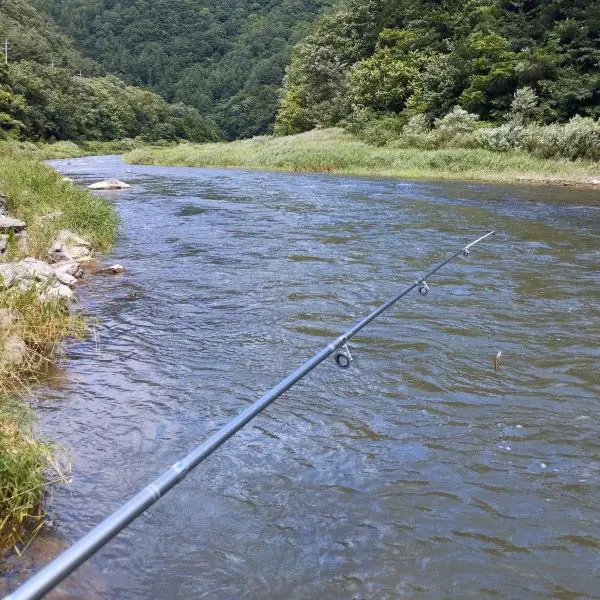One of the most productive rivers where I grew up nearly always flows dirty. During the summer, the water is constantly eroding mudstones, so the water is cloudy with sediment. Over winter, and spring the sediment is mixed even further by cloudy snow melt from the peaks behind. This river, seems to only flows clear for a couple of weeks every year. During extreme summer low flows, or the middle of winter when the headwaters are frozen.
This river also happens to be quite a productive trout fishery, although most local fishermen overlook it. They much prefer fishing the clear flowing rivers nearby. But, they are certainly missing out. I average more trout from the cloudy river than its much more prestigious neighbour.
The secret to catching trout in cloudy water is that the trout must be able to see the lure. I have spent hours fishing nymphs and dries, and barely caught a fish. The trout just struggle to see them through the murk. But, when I tie on a large bright streamer or take out my spinning tackle my fortunes change.
So this brings me to my first sub-section which is the best lure or bait to use when fishing dirty water.
When to fish for trout in dirty water?
Sometimes water is simply too muddy for trout fishing with lures. If you arrive to a river and it is the color of chocolate milk. I suggest driving somewhere a little cleaner. When fishing with either spinners or streamers, I like at least a foot of in the water visibility.
One simple way, to measure visibility is to wade out to about knee deep water. If you can see your boots, then the water is clear enough. Some fishermen find such conditions the best time for targeting returning Salmon.
If you are planning on fishing bait, then visibility is less important. Even then, I probably would avoid fishing pure mud. I doubt the trout will taste any good living in a brown soup.
Best lures for catching trout in dirty water
In this section, I am going to cover both spinning lures and fly fishing streamers. The same principals apply to both.
When selecting a lure to fish dirty water I want it to be obvious. Big, bold and bright. It needs to make a statement and be visible through the gloom.
For this reason, my favorite color when fishing water with low clarity is bright orange. Similar to what is found on a high vis shirt or a road cone. The more visible the better. The trout need to be able to see it.
If you are not prepared to fish a high visibility lure, then go for maximum contrast. Black is a great option. This is why many fly fishermen choose to fish a black woolly bugger when a river is in flood. Black contrasts well against the gloom and muck.
I also trend to fish large lures, normally a size or two bigger than I would fish when conditions are clear. The reason is simple, a bigger lure is simply easier to see, and a large lure also creates more vibrations through the water. Making it easier for the trout to sense. If the trout know there is a potential meal swimming past they are more likely to strike.
Finally, I like my lures to be loud. I want them to create a lot of vibrations, or noise through the water. Trout are not only visual hunters, they also hunt by sensing vibrations. So a noisy lure can work wonders.
Best spinning lures for dirty water?
When spinning, this noise can come from a rotating blade on an in-line spinner, or an internal rattle inside a hard minnow or jerk bait. There are even tiny rattles which can be inserted inside soft plastics.
One of my favorite inline spinners for dirty water trout fishing is the panther martin. That is because the oversized blade gives off a lot of vibrations. The blue fox vibrax is another good option. I have discuss both and other inline spinners in much more detail here.
When fishing jerkbaits, I really like the exaggerated action of a jointed Rapala. They work particularly well when there is not much current. In moving water, the choice is a bit harder, but I usually reach for a Yo-zuri pin minnow or a HD trout by Dynamic lures. For more tips, and advice on selecting the best jerkbaits for trout fishing I suggest reading my guide.
Best fly fishing streamers for dirty water?
There are also options for the fly angler. One of the simplest is to fish streamers with rubber legs or tails. These increase the resistance through the water increasing the vibrations.
Another option is to fish flies with large bulky heads. Deer hair bugs are a popular option.
There are also tiny ‘rattles’ which can be tied onto a fly. These create a little sound when retrieved through the water. Although I find they are quite fragile and easy to break. They exist but I am not convince they are worth the hassle.

Best baits to use to catch trout in dirty water?
Fish use many senses to find food. Trout primarily use their sight, and lateral line senses to find prey. But there is a third method, that is by scent. While some fish such as catfish and eels rely heavily on scent, trout seem to be much more visual hunters.
But that does not mean trout can not smell their food. They obviously have a great sense of smell, being able to return year after year to the the water they were spawned in.
When the water is dirty, fishing bait might just be the most effective way to catch trout. I personally rarely use bait to catch trout, that is because trout are likely to swallow the hook so this method of fishing is only useful when fishing for the table.
I find three baits work particularly well. These being nightcrawler (worm), Maggot or even a small minnow. I thread the nightcrawler or maggot onto a small hook and suspend it below a float, which I then allow to gently float downstream. When the float gets dragged under, chances are a fish is on.
Minnows can be fished in a similar way, for extra attraction. I like to use live minnows, not only do they give off a scent, their struggle also sends vibrations through the water which the trout can sense. Some of the biggest trophy trout I have seen were caught on minnows.
If you are targeting stock trout, then I suggest starting with nightcrawlers or maggots.
Where to find trout in dirt water?
Trout for the most part hold in the same types of locations no matter the clarity of water. Although, there are a few exceptions.
I have seen trout holding in spring eruption zones, as muddy flood water flowed all around them. Now, there could be several reasons why they are holding there but I found it interesting how they decided to seek out the pockets of crystal clear spring water.
Also, in areas where dirty water joins clean water, trout often patrol the margins. I suspect they do that to grab any insects which is being washed downstream by the flow. This often occurs where a river or stream flows into a lake.
When a river is in flood, trout often move towards the edges. That is partly because there is less current, but they might also be scavenging for drowned terrestrial insects. While I can not prove it, but I believe they are at the edge to get out of the worst of the current, and they will still be holding there no matter the clarity of the water.

